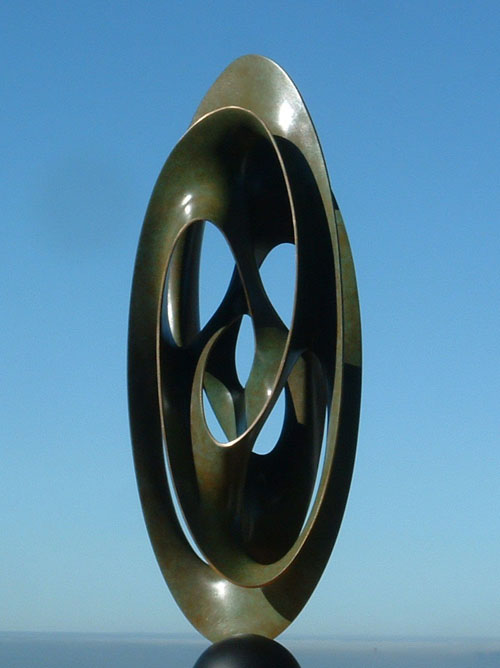Carlo Séquin
"Totem 3"
Bronze. Size: 13" tall. September, 2004.

Carlo H. Séquin is a professor of Computer Science at the University of California, Berkeley. He received his Ph.D degree in experimental physics from the University of Basel, Switzerland in 1969. His subsequent work at the Institute of Applied Physics in Basel concerned interface physics of MOS transistors and problems of applied electronics in the field of cybernetic models.
From 1970 till 1976 he worked at Bell Telephone Laboratories, Murray Hill, N.J., on the design and investigation of Charge-Coupled Devices for imaging and signal processing applications. At Bell Labs he also got introduced to the world of Computer Graphics in classes given by Ken Knowlton.
In 1977 he joined the faculty in the EECS Department at Berkeley. He started out by teaching courses on the subject of very large-scale integrated (VLSI) circuits, thereby trying to build a bridge between the CS division and the EE faculty. In the early 1980's, jointly with D. Patterson he introduced the `RISC' concept to the world of microcomputers. He was head of the Computer Science Division from 1980 till 1983. Since then he has concentrated on computer graphics, geometric modeling, and on the development of computer aided design (CAD) tools for circuit designers, architects, and for mechanical engineers. During the last five years he has collaborated with P. Wright in Mechanical Engineering on the CyberCut/CyberBuild project with the goal to streamline the path from creative design to rapid prototyping.
Séquin's work in computer graphics and in geometric design have also provided a bridge to the world of art. In collaboration with a few sculptors of abstract geometric art, in particular with Brent Collins, Séquin has found a new interest and yet another domain where the use of computer-aided tools can be explored and where new frontiers can be opened through the use of such tools.
Dr. Séquin is a Fellow of the ACM, a Fellow of the IEEE, and has been elected to the Swiss Academy of Engineering Sciences.
"Since high school I have been fascinated by geometry. I enjoyed constructing the more complicated Platonic solids with ruler and compasses, as well as reading about the 4th dimension. I went on to study physics at the University of Basel, and in 1970 started working at Bell Telephone Laboratories on the design of Charge-Coupled Imaging Devices. There, in Murray Hill, I was introduced to the field of Computer Graphics in courses given by Ken Knowlton and Lilian Schwartz.
In 1977, I joined the faculty of the Computer Science Division at the University of California, Berkeley. Inspired by a talk by artist Frank Smullin, I started to develop the Berkeley UniGrafix rendering system, so that I could depict objects such as the "Skeleton of a Klein Bottle" or the "Granny-Knot Lattice." Since then, the focus of my work has been on computer-aided design (CAD). First I developed programs to support circuit designers, later architects and mechanical engineers, and recently even artists.
In 1995, I started a close collaboration with Brent Collins, who had been sculpting abstract geometric art for two decades. With my students, I developed a procedural "Sculpture Generator" program, to help Collins prototype potential future work in virtual form. Later programs generalized the original concepts, and eventually expanded the design space through new paradigms. In this work I see myself as a composer in the realm of pure geometry. The artistic achievement lies in finding a procedural formulation that can reflect the inherent symmetries and constructive elegance that seems to lie beneath the physical laws of our universe."
Totem 3 is a special instance of the Scherk-Collins Toroid paradigm, which started with Collins' "Hyperbolic Hexagon." Collins'original sculpture can be understood as a six-story tower cut from the center of Scherk's "Second Minimal Surface," bent through 360 degrees, and closed into a toroidal loop. Séquin's "Sculpture Generator I" captures this construction in a procedural form and generalizes it to include "Scherk Towers" with an arbitrary number of saddle stories and which have some twist applied to them, before the tower is closed into the toroidal ring.
Later Séquin enhanced his program to allow not just ordinary 2nd-order (equestrian) saddles, but also higher-order saddles in which more than two valleys slope down from the central saddle point, separated by an equal number of upwards-bent ridges. In a further extension of the Scherk-Collins paradigm, it was found that one can wind the saddle-chain more than once around the toroidal ring. For a double loop, one would choose an odd number of stories, so that they properly intertwine on the first and second round. With an appropriate amount of twist and flange-extensions, all self-intersection can be avoided. In the Totem series, Séquin is experimenting with yet another extension: subjecting the toroidal structures to affine transformations via non-uniform scaling. Often a piece of geometric art becomes more dynamic and more interesting when its inherent symmetry is broken in a judicious way.
Other artwork by Carlo may be seen at: http://www.cs.berkeley.edu/~sequin/SCULPTS/sequin

